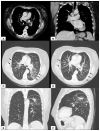Sarcoidosis with hepatic involvement in a 60-year-old patient
- PMID: 35529425
- PMCID: PMC9063835
- DOI: 10.3941/jrcr.v16i3.4191
Sarcoidosis with hepatic involvement in a 60-year-old patient
Abstract
Hepatic involvement of sarcoidosis is usually hard to detect on radiological imaging. We present a case of a 60-year-old female with symptoms of pulmonary sarcoidosis. Subsequent imaging work-up showed diffuse hepatic granulomas consistent with abdominal involvement of sarcoidosis. A literature review regarding hepatic sarcoidosis is provided and radiological appearances as well as considerations for differential diagnosis are described.
Keywords: Abdominal sarcoidosis; Computed tomography; Hepatic granulomas; Hepatic sarcoidosis; Sarcoidosis.
Copyright Journal of Radiology Case Reports.
Figures






References
-
- Judson MA.Extrapulmonary sarcoidosis Semin Respir Crit Care Med 2007. Feb28183–101. - PubMed
-
- Baughman RP, Teirstein AS, Judson MA, et al. Case Control Etiologic Study of Sarcoidosis (ACCESS) research group. Clinical characteristics of patients in a case control study of sarcoidosis. Am J Respir Crit Care Med. 2001 Nov 15;164(10 Pt 1):1885–9. - PubMed
-
- Rybicki BA, Major M, Popovich J, Jr, Maliarik MJ, Iannuzzi MC. Racial differences in sarcoidosis incidence: a 5-year study in a health maintenance organization. Am J Epidemiol. 1997 Feb 1;145(3):234–41. - PubMed
-
- Culver DA. Sarcoidosis. Immunol Allergy Clin North Am. 2012 Nov;32(4):487–511. - PubMed
-
- Kahi CJ, Saxena R, Temkit M, Canlas K, Roberts S, Knox K, Wilkes D, Kwo PY. Hepatobiliary disease in sarcoidosis. Sarcoidosis Vasc Diffuse Lung Dis. 2006 Jun;23(2):117–23. - PubMed
Publication types
MeSH terms
LinkOut - more resources
Full Text Sources
Medical

